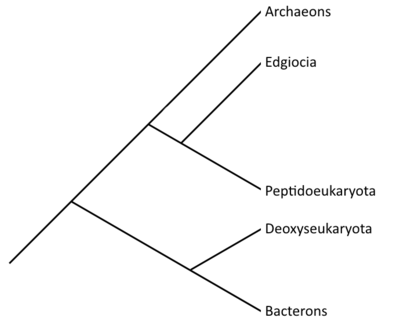Saunvare
Saunvare is a planet with life, but is uninhabitable by humans except for on high peaks. Its temperatures are very warm compared with Earth, with an average global temperature around 51 degrees Celsius (124°F). Most of its life is bizarrely unlike our own, with a variety of adaptations to the extreme global heat.
Contents
Climate
Lifeforms
Domains
Saunvare has four main domains of life, two of which have multicellular creatures within them. A very large split is present in lifeforms on Saunvare, being divided into DNA-using life and RNA-using life. They live mostly in seclusion from each other, giving Saunvare the appearance as if it is two different planets on one.
Bacterons
All bacterons are unicellular, have few organelles, and use DNA to code genetic information. They are generally small, simple cells which live mainly high in the atmosphere, on mountain peaks, and in polar regions due to the temperatures of the tropics being so high as to denature DNA, especially in deserts. A few species of bacterons can function properly with single-stranded DNA, but they have much smaller genomes than those with double-stranded DNA.
Archaeons
Archaeons are similar to bacterons in that they also are unicellular and have few organelles. But, they use RNA to store genetic information and perform enzymatic work. They often have few proteins but these proteins are consistent across species as they are used in processing waste. They exist in a variety of environments toxic to all higher life on Saunvare and are the main source of Saunvare's large proportions of methane in its atmosphere.
Riboseukaryota
Genetic information in riboseukaryota is carried by RNA. In riboseukaryota, there is a distinct split between RNA used for the genome and RNA used as proteins, with genomic RNA being packaged in the nucleus of the cell. These cells often have more organelles than archaeons and bacterons, but some species do lack organelles, especially those more adapted for parasitism. Riboseukaryota contains almost all multicellular life on Saunvare, containing all photosynthetic multicellular creatures along with several other kingdoms, some of which have photosynthetic clades within them. They are the most common in the tropics and in the oceans and are often more dependent on water than deoxyeukaryota.
Deoxyeukaryota
Deoxyeukaryotae use DNA to carry genetic information, the equivalent of bacterons. Their forms between the northern and southern hemisphere are wildly different, especially for those who cannot fly. They often are much larger than riboseukaryotae with larger genomes, but they are limited in their distribution. A number of them are multicellular creatures. They are much less numerous than riboseukaryota and mainly occupy polar regions and the air.
